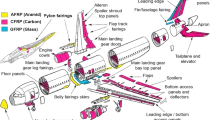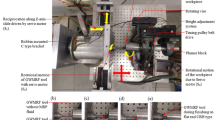Abstract
Drilling is a key link of manufacturing carbon fiber-reinforced polymer (CFRP) components. However, due to CFRP’s anisotropy and heterogeneity, effects of drilling induced axial force and hole-exit temperature are much more complicated than conventional metals, which always results in undesirable surface damages at hole exit hindering the engineering application of CFRP. Since the axial force and the hole-exit temperature are highly correlated to process parameters in drilling of CFRP, for effectively overcoming such difficulties, this study focuses on optimized selection of process parameters. The suitable ranges of the axial force and the hole-exit temperature are figured out, upon the specific analysis on the combined effects of the axial force and the hole-exit temperature on the formation of hole-exit surface damages. With that, through establishing the relations between the axial force, the hole-exit temperature, and the drilling parameters, the optimized drilling parameters are finally given. By experimental verifications, it is found that the optimized drilling parameters can control the axial force and the hole-exit temperature within the suitable ranges, and thereby effectively suppress the hole-exit surface damages in drilling of CFRP. The findings of this study will be helpful to further improve the drilling qualities of CFRP.
















Similar content being viewed by others

References
Wang H, Cong W, Ning F, Hu Y (2018) A study on the effects of machining variables in surface grinding of CFRP composites using rotary ultrasonic machining. Int J Adv Manuf Technol 95(9–12):3651–3663. https://doi.org/10.1007/s00170-017-1468-6
Silva D, Teixeira JP, Machado CM (2014) Methodology analysis for evaluation of drilling-induced damage in composites. Int J Adv Manuf Technol 71(9–12):1919–1928. https://doi.org/10.1007/s00170-014-5616-y
Jia Z, Fu R, Niu B, Qian B, Bai Y, Wang F (2016) Novel drill structure for damage reduction in drilling CFRP composites. Int J Mach Tools Manuf 110:55–65. https://doi.org/10.1016/j.ijmachtools.2016.08.006
Wang F, Zhang B, Zhao M, Cheng D, Wang Z (2019) Evolution laws of fiber-matrix interface cracks in machining of carbon fiber reinforced polymer. Int J Adv Manuf Technol 101:963–977. https://doi.org/10.1007/s00170-018-2992-8
Anand RS, Patra K (2018) Cutting force and hole quality analysis in micro-drilling of CFRP. Mater Manuf Process 33(12):1369–1377. https://doi.org/10.1080/10426914.2017.1401715
Faraz A, Biermann D, Weinert K (2009) Cutting edge rounding: an innovative tool wear criterion in drilling CFRP composite laminates. Int J Mach Tools Manuf 49(15):1185–1196. https://doi.org/10.1016/j.ijmachtools.2009.08.002
Wang F, Zhang B, Jia Z, Zhao X, Wang Q (2019) Structural optimization method of multitooth cutter for surface damages suppression in edge trimming of carbon fiber reinforced plastics. J Manuf Process 46:204–213. https://doi.org/10.1016/j.jmapro.2019.09.013
Hocheng H, Dharan CKH (1990) Delamination during drilling in composite laminates. J Eng Ind Trans ASME 112(3):236–239. https://doi.org/10.1115/1.2899580
Girot F, Dau F, Gutiérrez-Orrantia M (2017) New analytical model for delamination of CFRP during drilling. J Mater Process Technol 240:332–343. https://doi.org/10.1016/j.jmatprotec.2016.10.007
Fu R, Jia Z, Wang F, Jin Y, Sun D, Yang L, Cheng D (2018) Drill-exit temperature characteristics in drilling of UD and MD CFRP composites based on infrared thermography. Int J Mach Tools Manuf 135:24–37. https://doi.org/10.1016/j.ijmachtools.2018.08.002
Jain S, Yang DCH (1993) Effects of feedrate and chisel edge on delamination in composites drilling. J Eng Ind Trans ASME 115:398–405. https://doi.org/10.1115/1.2901782
Hocheng H, Tsao C (2003) Comprehensive analysis of delamination in drilling of composite materials with various drill bits. J Mater Process Technol 140:335–339. https://doi.org/10.1016/S0924-0136(03)00749-0
Jain S, Yang DCH (1994) Delamination-free drilling of composite laminates. J Eng Ind Trans ASME 116:475–481. https://doi.org/10.1115/1.2902131
Tsao C (2008) Experimental study of drilling composite materials with step-core drill. Mater Design 29:1740–1744. https://doi.org/10.1016/j.matdes.2008.03.022
Davim J, Reis P (2003) Drilling carbon fiber reinforced plastics manufactured by autoclave-experimental and statistical study. Mater Design 24:315–324. https://doi.org/10.1016/S0261-3069(03)00062-1
Karpat Y, Değer B, Bahtiyar O (2012) Drilling thick fabric woven CFRP laminates with double point angle drills. J Mater Process Technol 212:2117–2127. https://doi.org/10.1016/j.jmatprotec.2012.05.017
Wang B, Gao H, Wen Q, Wu M, Zhang S (2012) Influence of cutting heat on quality of drilling of carbon/epoxy composites. Mater Manuf Process 27(9):968–972. https://doi.org/10.1080/10426914.2011.610079
Xia T (2014) Investigation of drilling performance in cryogenic drilling on CFRP composite laminates. University of Kentucky, Dissertation
Sorbo NW, Dionne JJ (2014) Dry drilling of stackup composite: benefits of CO2 cooling. B Am Math Soc 7:156–163. https://doi.org/10.4271/2014-01-2234
Weinert K, Kempmann C (2004) Cutting temperatures and their effects on the machining behaviour in drilling reinforced plastic composites. Adv Eng Mater 6(8):684–689. https://doi.org/10.1002/adem.200400025
Merino-Perez JL, Royer R, Merson E, Lockwood A, Ayvar-Soberanis S, Marshall MB (2016) Influence of workpiece constituents and cutting speed on the cutting forces developed in the conventional drilling of CFRP composites. Compos Struct 140:621–629. https://doi.org/10.1016/j.compstruct.2016.01.008
Mu J, Xu J, Chen Y, Fu Y (2014) Experimental research on temperature of drilling CFRP with brazed diamond core drill. Mater Sci Forum 800-801:776–781. https://doi.org/10.4028/www.scientific.net/MSF.800-801.776
Xu J, An Q, Chen M (2014) A comparative evaluation of polycrystalline diamond drills in drilling high-strength T800S/250F CFRP. Compos Struct 117:71–82. https://doi.org/10.1016/j.compstruct.2014.06.034
Li Y, Zhao J, Ji S (2018) Thermal positioning error modeling of machine tools using a bat algorithm-based back propagation neural network. Int J Adv Manuf Technol 97:2575–2586. https://doi.org/10.1007/s00170-018-1978-x
Kumar NP, Devarajan PK, Vendan SA, Shanmugam N (2017) Prediction of bead geometry in cold metal transfer welding using back propagation neural network. Int J Adv Manuf Technol 93:385–392. https://doi.org/10.1007/s00170-016-9562-8
Li K, Yan S, Pan W, Zhao G (2017) Warpage optimization of fiber-reinforced composite injection molding by combining back propagation neural network and genetic algorithm. Int J Adv Manuf Technol 90:963–970. https://doi.org/10.1007/s00170-016-9409-3
Funding
This work was supported by National Key R&D Program of China (Grant No. 2018YFA0702803), Liaoning Revitalization Talents Program (Grant No. XLYC1902014), Liaoning Revitalization Talents Program (Grant No. XLYC1801008), and Fundamental Research Funds for the Central Universities (Grant No. DUT19GF104).
Author information
Authors and Affiliations
Corresponding author
Additional information
Publisher’s note
Springer Nature remains neutral with regard to jurisdictional claims in published maps and institutional affiliations.
Rights and permissions
About this article
Cite this article
Zhang, B., Wang, F., Wang, X. et al. Optimized selection of process parameters based on reasonable control of axial force and hole-exit temperature in drilling of CFRP. Int J Adv Manuf Technol 110, 797–812 (2020). https://doi.org/10.1007/s00170-020-05868-9
Received:
Accepted:
Published:
Issue Date:
DOI: https://doi.org/10.1007/s00170-020-05868-9



